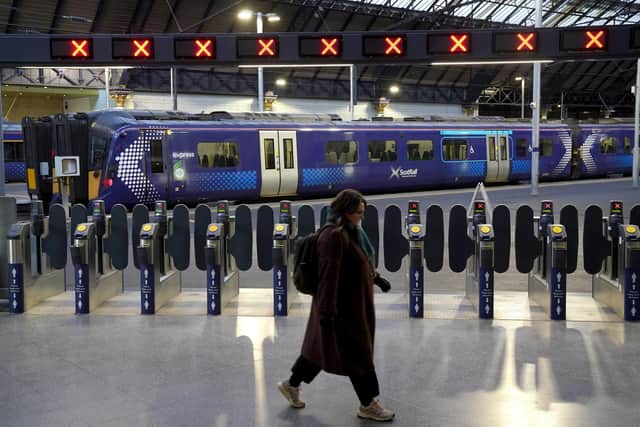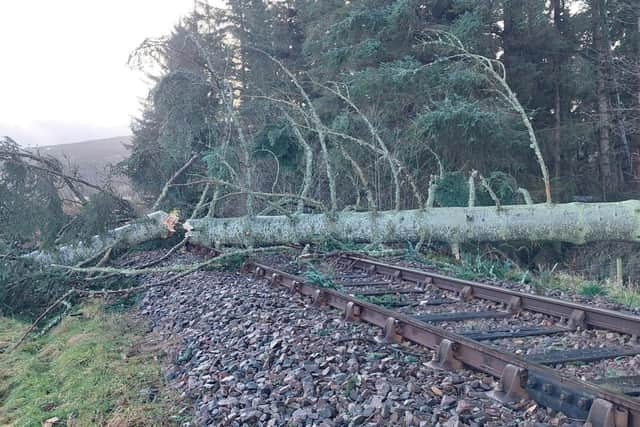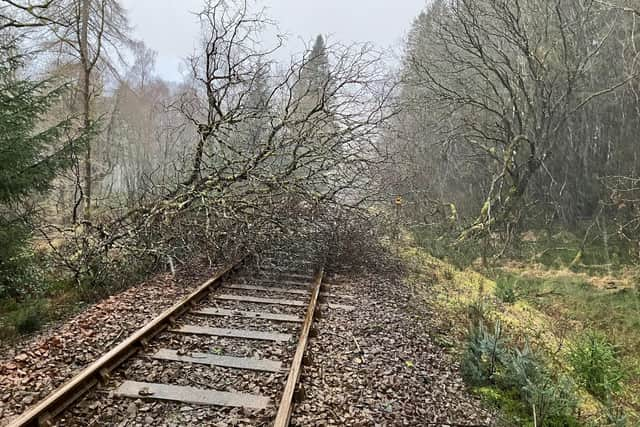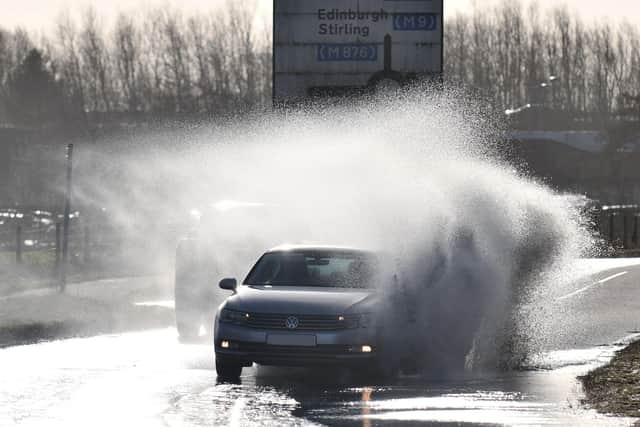Scotland storms rail shutdowns: Passengers warned to expect more frequent disruption amid ‘more rain and wind than ever before’
More frequent disruption from extreme weather is expected by rail chiefs after an unprecedented two shutdowns of the Scottish rail network in three nights, The Scotsman has been told.
They said Scotland was experiencing “more storms, more rain and more wind than ever before”.
Advertisement
Hide AdAdvertisement
Hide AdThe admission came as Scottish and Southern Electricity Networks (SSEN) Distribution confirmed as of 5pm on Wednesday, only fewer than 100 properties remained without power.


A gust of 74mph was recorded in South Uist around 10pm on Tuesday night as the country’s north was hit by several hours of gale-force winds.
A Met Office yellow warning covering most of Scotland for winds of up to 70mph ended up being extended by two hours until 3pm on Wednesday.
Transport secretary Mairi McAllan, launching the Beyond Net Zero Initiative by the Universities of Edinburgh and Glasgow to address the climate emergency, said: “We are in the midst of a storm season of unusual severity and frequency … our people, our communities, our infrastructure are being challenged by this.”
Rail lines were being checked for damage and obstructions on Wednesday morning after amber level Storm Jocelyn prompted the closure of all routes north of the Border from 7pm on Tuesday. Network Rail used eight locomotives to “prove” the lines along with foot patrols, its helicopter and empty passenger trains.


That came just 48 hours after trains across Scotland were similarly halted from 7pm on Sunday ahead of the amber level Storm Isha, which brought down large trees across lines.
Network Rail said it had opened most routes by 11am, but the Inverness-Perth line remained closed at Dalguise, south of Pitlochry, due to flooding below a viaduct delaying inspections for damage.
The body tweeted: “We’re now working with train operators to reintroduce services as soon as we can. This will take time as they work to get trains and crews into position.”
Advertisement
Hide AdAdvertisement
Hide AdObstructions found on lines included a trampoline at Livingston South that required power to the overhead lines being switched off while it was removed.


Fallen trees were found on the West Highland Line between Fort William and Crianlarich and at Bellgrove, east of Glasgow city centre. Flooding affected lines at Helensburgh and between Glasgow and Dumfries.
The infrastructure body has become increasingly risk averse following a series of severe weather incidents such as debris washed from a wrongly-built drain by a downpour derailing a ScotRail train at Carmont in Aberdeenshire in 2020, in which three people aboard died.
Several other trains have hit landslides and trees, although most without injuries.
On Tuesday, an investigation was announced by the UK Department for Transport’s Rail Accident Investigation Branch (RAIB) after a ScotRail train hit a fallen tree at 84mph near Broughty Ferry during Storm Gerrit on December 27.


The Scotsman understands the investigation will include the alarm being raised with Network Rail via an emergency line ten minutes before the collision, in which the train driver was injured and their fibreglass cab “heavily damaged” when the tree tore through it.
The RAIB will also consider factors such as the management of trains during bad weather, how risks from trees falling on to the railway are managed and controlled, and the crashworthiness of the 40-year-old train.
A rail industry source said passengers should expect more frequent weather disruption. They told The Scotsman: “Not necessarily closures like we have seen this week – these storms were different in that they impacted the entire nation and as such closure was the safest approach.
Advertisement
Hide AdAdvertisement
Hide Ad"But the reality is climate change is having a major impact on the railway with more storms, more rain and more wind than ever before and so I expect disruption to the railway to become more frequent. That might mean more speed restrictions or more delays, or even closures.”
Another industry source said: “Scotland is ahead of the rest of the UK on this and more vulnerable. The severe weather events are simply more frequent.
"Network Rail might be more risk averse than it used to be, which is perhaps not surprising. It is seemingly not enough now to examine a line with the first train running cautiously – a special inspection train must be used and lots of structures inspected by engineers before the railway can reopen.
“Network Rail has and will invest heavily in resilience, but it’s a huge task, and a ‘thankless spend’. The railway wasn't built or maintained over the last century to withstand this kind of weather regularly.
“Meanwhile, folk take to their cars, probably taking more risk than if they were on a train in similar weather conditions. Societal risk is a more vague concept than that involved in running a railway."
A Network Rail spokesperson said: “We are seeing more named storm events now than we have in the past and a general increase in volumes of rain across Scotland. Our geography is also more of an issue than it is for many routes south of the Border. Much of our infrastructure is coastal or runs through very mountainous terrain.
"More of the railway in Scotland is also electrified, meaning high winds can cause us more issues than Wales, for example.
"The railway industry is run according to standards and procedures agreed with our independent regulator. We work within the agreed operating procedures and make decisions based on the conditions we expect to experience during individual storm events.
Advertisement
Hide AdAdvertisement
Hide Ad"It’s not health and safety teams making these decisions – it’s our control team who run the railway in all weathers.”
The spokesperson said Network Rail “had confidence in our assets, invest millions of pounds every year in their maintenance and inspect them regularly”.
However, they added: “This does not mean they may not be overwhelmed in some extremes of weather like the conditions seen in some amber and red storms. Another major factor is that many of the issues we face on storm days originate outwith the railway.
"Trees and flooding on our infrastructure regularly come from third party land over which we have no control, so we need to factor those external risks into how we manage extreme weather events.”
SSEN said supplies have been successfully restored to 7,000 customers who lost power due to Storm Jocelyn.
Andy Smith, operations director at SSEN Distribution, said: “Our network held up well overnight, despite Jocelyn’s severe, sustained winds. Our teams have worked hard in challenging conditions all day to reconnect customers.
"Tonight, we’re pushing on with reconnecting the final few remaining customers still off supply. We’re on track to do so this evening, and I would like to thank customers for their patience. I would also like to thank our teams for their tireless work over the last few days reconnecting homes across the north of Scotland.
“I’d like to also remind people who’ve been off for more than 12 hours of the compensation they can claim for any food and drink costs today.” Those impacted are entitled to claim £30 per person for every day off supply, to cover the cost of food and drink.
Comments
Want to join the conversation? Please or to comment on this article.